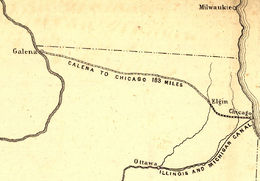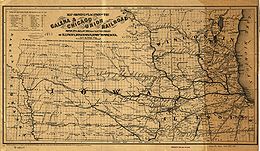
West Chicago is a city in DuPage County, Illinois, United States. The population was 25,614 at the 2020 census. It was formerly named Junction and later Turner, after its founder, John B. Turner, president of the Galena and Chicago Union Railroad (G&CU) in 1855. The city was initially established around the first junction of railroad lines in Illinois, and today is still served by the Union Pacific West Metra service via West Chicago station.

Pecatonica is a village in Winnebago County, Illinois, United States. It is part of the Rockford, Illinois Metropolitan Statistical Area. The population was 2,195 at the 2010 census, up from 1,997 in 2000.

The Chicago and North Western was a Class I railroad in the Midwestern United States. It was also known as the "North Western". The railroad operated more than 5,000 miles (8,000 km) of track at the turn of the 20th century, and over 12,000 miles (19,000 km) of track in seven states before retrenchment in the late 1970s. Until 1972, when the employees purchased the company, it was named the Chicago and North Western Railway.

The Illinois Central Railroad, sometimes called the Main Line of Mid-America, was a railroad in the Central United States. Its primary routes connected Chicago, Illinois, with New Orleans, Louisiana, and Mobile, Alabama, and thus, the Great Lakes to the Gulf of Mexico. Another line connected Chicago west to Sioux City, Iowa (1870), while smaller branches reached Omaha, Nebraska (1899) from Fort Dodge, Iowa, and Sioux Falls, South Dakota (1877), from Cherokee, Iowa. The IC also ran service to Miami, Florida, on trackage owned by other railroads.
The following railroads have been named Union Railroad or Union Railway, usually because they connected or merged several other railroads.

The Union Pacific West Line (UP-W) is a Metra commuter rail line operated by Union Pacific Railroad in Chicago, Illinois and its western suburbs. Metra does not refer to its lines by particular colors, but the timetable accents for the Union Pacific West line are "Kate Shelley Rose" pink, honoring an Iowa woman who saved a Chicago & North Western Railway train from disaster in 1881. Green and yellow were already selected for the Union Pacific North Line and Union Pacific Northwest Line, respectively, so pink was chosen for this line. Therefore, the UP-W is the only Metra line that uses a color to honor a person instead of a fallen flag railroad. Until the late 1940s the line had a branch to Freeport, Illinois. It diverged from the main line at West Chicago and had stations at Elgin, Marengo, Belvidere, Rockford, Freeport, and other communities. The line was once known as the Chicago & Northwestern/West Line until UP took over the C&NW in 1995. All Metra trains on this line terminated at Geneva until 2006, when the line was extended to its present terminus in Elburn. The line runs as part of the Union Pacific Railroad's Geneva Subdivision.
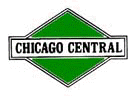
The Chicago Central and Pacific Railroad is part of the Illinois Central Railroad (IC), which is owned by the Canadian National Railway (CN) through the Grand Trunk Corporation. Operationally, the Chicago Central & Pacific is designated as the Iowa Zone of CN's Southern Region.
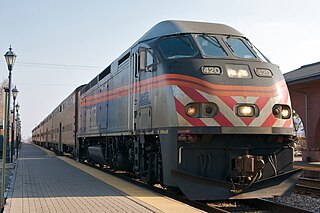
The Milwaukee District West Line (MD-W) is a Metra commuter rail line in Chicago, Illinois, and its western suburbs. Metra does not refer to any of its lines by a particular color, but the timetable accents for the Milwaukee District West line are dark "Arrow Yellow," honoring the Milwaukee Road's Arrow passenger train. Trains are dispatched from the Canadian Pacific Kansas City Railway's American headquarters in Minneapolis.

The Black Hawk was an Amtrak passenger train service that operated from 1974 to 1981 between Chicago, Illinois, and Dubuque, Iowa, via Rockford, Illinois. The original Black Hawk operated over the Illinois Central route, now the Canadian National's Chicago Central/Iowa Zone.
The Pittsburgh, Fort Wayne and Chicago Railway was a major part of the Pennsylvania Railroad system, extending the PRR west from Pittsburgh, Pennsylvania, via Fort Wayne, Indiana, to Chicago, Illinois. It included the current Norfolk Southern-owned Fort Wayne Line east of Crestline, Ohio, to Pittsburgh, and the Fort Wayne Secondary, owned by CSX, from Crestline west to Tolleston in Gary, Indiana. CSX leased its entire portion in 2004 to the Chicago, Fort Wayne and Eastern Railroad (CFE). The remaining portion of the line from Tolleston into Chicago is now part of the Norfolk Southern's Chicago District, with a small portion of the original PFW&C trackage abandoned in favor of the parallel lines of former competitors which are now part of the modern NS system.

The Pittsburgh, Cincinnati, Chicago and St. Louis Railroad, commonly called the Pan Handle Route, was a railroad that was part of the Pennsylvania Railroad system. Its common name came from its main line, which began at Pittsburgh, Pennsylvania, crossed the Northern Panhandle of West Virginia, and continued west to Bradford, Ohio, where it split into a northern line to Chicago and a southern one through Indianapolis, Indiana, to East St. Louis, Illinois.

Wells Street Station was a passenger terminal of the Chicago and North Western Railway, located at the southwest corner of Wells Street and Kinzie Street in Chicago, Illinois. It was replaced in 1911 by the Chicago and North Western Terminal on the other (west) side of the North Branch of the Chicago River, removing passenger trains from the Kinzie Street railroad bridge over the river. The Merchandise Mart opened in 1930 on the land formerly occupied by the station.

The Clinton Railroad Bridge, also called the Chicago and Northwestern Railway Bridge or more simply the Clinton Bridge, is a bridge that carries double tracked rail lines across the Mississippi River between Clinton, Iowa, and Fulton (Albany), Illinois. The bridge is a truss bridge with a swing span crossing the main river channel and is adjacent to the Gateway Bridge. The original bridge was constructed in 1858, and the first train crossed the bridge on January 19, 1860. The bridge was the second railroad crossing over the Mississippi River. In 1870, the bridge was declared a post route, therefore stopping the occupation of steamboats and approval of railroads. From 1859 to 1908, the mileage in operation increased from 28,789 to 229,230, prompting the Chicago and North Western Railway to replace the bridge with a new structure in 1900.

U.S. Route 20 (US 20) in the U.S. state of Illinois is a major arterial highway that runs from the Iowa state line at East Dubuque at the northwestern tip of Illinois to the Indiana state line at Chicago south of the Chicago Skyway, a distance of 233.93 miles (376.47 km). For its entire length, US 20 is designated as the General Ulysses S. Grant Highway, often abbreviated the U.S. Grant Memorial Highway. However, this name is only commonly used west of Elgin. US 20 bypasses the city of Elgin on a freeway known as the Elgin Bypass or Dr. Martin Luther King Jr. Memorial Highway. From Elgin to Melrose Park, US 20 follows Lake Street. It then follows Mannheim Road and, further south, La Grange Road. US 20 also follows 95th Street as it turns east through Chicago's southwestern suburbs. It ultimately leaves Illinois on Indianapolis Boulevard.

The Chicago and Aurora Railroad was a direct predecessor of the Chicago, Burlington and Quincy Railroad. Its original incorporation as the Aurora Branch Railroad, chartered in February 1849, started as a twelve-mile branch line which Class I giant BNSF cites as the beginning of their empire: this “short stretch of track set BNSF’s destiny into ‘loco-motion’ and grew over many decades into a network spanning 32,500 miles.” Beginning in 1853, as the Chicago and Aurora Railroad, the company's tracks eventually extended from Chicago to Mendota via Aurora, Illinois, also creating what would become the oldest commuter line in the Chicago area.
The Galena–Chicago trail was a stagecoach route located in northern Illinois that ran from the mid-to-late 1830s until 1854. As indicated by its name, the route linked Chicago, located in the northeast of the state, with Galena which was located in the lead mining district of the northwest. The Chicago-Galena trail includes the "Stagecoach Trail" that runs between Galena and Lena, Illinois. East of Lena the stage route follows U.S. Route 20 and Business U.S. Route 20 through Eleroy, Freeport and Rockford to Belvidere. This road began as the old State Road number 2 established on 15 January 1836 and laid out by June 1837.

The Maine Central Railroad Company main line extended from Portland, Maine, east to the Canada–US border with New Brunswick at the Saint Croix–Vanceboro Railway Bridge. It is the transportation artery linking Maine cities to the national railway network. Sections of the main line had been built by predecessor railroads consolidated as the Maine Central in 1862 and extended to the Canada–US border in 1882. Through the early 20th century, the main line was double track from South Portland to Royal Junction, where it split into a lower road through Brunswick and Augusta and a back road through Lewiston which converged at Waterville into single track to Bangor and points east. Westbound trains typically used the lower road with lighter grades, while eastbound trains of empty cars used the back road. This historical description does not include changes following purchase of the Maine Central Railroad by Guilford Transportation Industries in 1981 and subsequent operation as part of Pan Am Railways.

The Cleveland, Painesville and Ashtabula Railroad (CP&A), also known informally as the Cleveland and Erie Railroad, the Cleveland and Buffalo Railroad, and the Lake Shore Railroad, was a railway which ran from Cleveland, Ohio, to the Ohio-Pennsylvania border. Founded in 1848, the line opened in 1852. The railroad completed the rail link between Buffalo, New York, and Chicago, Illinois.
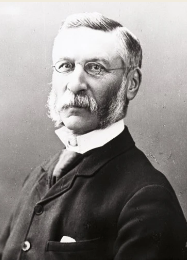
James Matthews was a prominent 19th-century architect in northern Scotland who also served as Lord Provost of Aberdeen from 1883 to 1886 during which time he enacted an important city improvement plan. His work as an architect is largely in the Scots baronial style.
